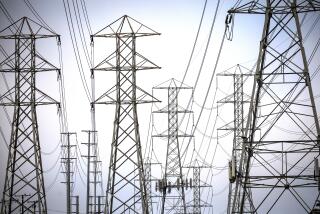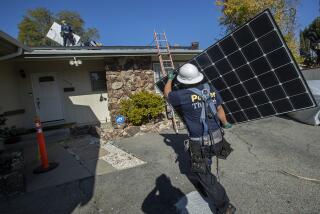New reasons to soak up the sun
- Share via
FOLKER KORTE racked up $21,000 worth of energy-saving upgrades to his single-story, three-bedroom home in San Pedro last year but only spent $9,000.
Plus, he didn’t have to fork over the full amount for the several rooftop solar panels and then wait for a rebate. Korte paid for his portion, and his contractor obtained the balance from the Los Angeles Department of Water and Power through its Solar Incentive Program.
For the record:
12:00 a.m. Aug. 6, 2006 For The Record
Los Angeles Times Sunday August 06, 2006 Home Edition Real Estate Part K Page 16 Features Desk 0 inches; 26 words Type of Material: Correction
Solar energy: In a July 30 article, a member of the American Solar Energy Society board was identified as Alan Black. His name is Andy Black.
For The Record
Los Angeles Times Sunday August 06, 2006 Home Edition Main News Part A Page 2 National Desk 0 inches; 28 words Type of Material: Correction
Solar energy: A Real Estate section article on July 30 identified a member of the American Solar Energy Society board as Alan Black. His name is Andy Black.
That’s only the beginning. Korte was also eligible for up to $2,000 in federal tax credits. His electricity bill has dropped from a monthly average of $90 to $30. And, as the price of oil soars, the solar panels increase the appeal and value of his home.
The costs of eco-renovations such as solar energy systems, insulation and energy-efficient appliances are more than offset by the resulting increase in market value to the home, experts and studies say. Some realty agents even use energy-saving attributes in their marketing pitches, listing a home’s solar distinction alongside the swimming pool and spa.
For every $1 saved in annual utility costs, analysts have suggested that a $20 increase in home value results. Following this formula, Korte’s utility bill savings of $60 a month or $720 a year would result in an increase in the value of his home by more than $14,000. Not bad for a $9,000 out-of-pocket expense.
A consumer survey conducted in May by Sharp Electronics Corp. found that 64% of the 1,004 polled said they’d be willing to pay more for a home with a solar-power system.
Alan Black, a solar financial analyst in San Jose and a member of the board of the American Solar Energy Society, says homeowners often find that the savings on the electric bill offset the loan payments sometimes necessary to finance a home improvement like solar, which can cost $16,000 to $20,000, or more, before rebates.
In years past, some homeowners have steered clear of energy-saving improvements because they didn’t intend to stay in the home long enough to recoup the investment through utility-bill savings. However, that mind-set may change if a slowing housing market and rising oil prices reveal that homes with energy-saving features sell faster and at higher prices.
Much the same way that greater numbers of drivers have begun to seek fuel-saving hybrid vehicles, real estate agents say they are seeing more buyers concerned with energy efficiency.
“Twenty years from now, if it’s not solar, it’s going to be a fixer,” said Donna Benton, a real estate agent with Re/Max Westside Properties in Santa Monica. “I just sold one in Encino and we made it part of the marketing: ‘Solar pool and solar spa.’ ”
Lori McGuire, an agent with Re/Max Real Estate Services in Dana Point, also emphasized energy savings when advertising a solar home she sold 18 months ago. “The first line was ‘Save costs with solar energy,’ ” said McGuire, who’s been an agent for 21 years. There’s even a category in the Multiple Listing Service where you can search for homes with solar energy, she added.
Ellen Mackey, who lives in a 1950s ranch house in Sun Valley, was thinking solar when she went shopping for a home, insisting on one with good southern rooftop exposure to the sun; about 200 square feet of unshaded rooftop is necessary.
After purchasing the home, her first step toward reducing her energy costs was to take out all the incandescent light bulbs, replacing them with fluorescent. Mackey installed Solatubes, which deliver sunlight to ceiling-mounted skylights, cutting down on the need for electric light during the daytime. And she tinted her windows to help keep out the heat. Then in 1998, the Department of Water and Power approached her about installing solar panels on her rooftop as part of a demonstration project.
Together, the improvements have helped Mackey cut energy consumption so much that she uses only as much power as the solar panels produce. The panels further keep the house cool by insulating a large portion of the rooftop from the sun.
The downside for Mackey is that she doesn’t own the panels, so the L.A. department owns the energy they produce. As a result, Mackey still has to pay an average monthly electricity bill of $40. But, when the demonstration period ends, Mackey plans to purchase the panels from the department, and then, she says, her monthly electricity bill will disappear. If the system ends up generating more power than Mackey uses, Water and Power would send her money, instead of an invoice.
Mackey emphasizes that point when solar-curious visitors wander through the 1,795-square-foot house each October as part the Eco-Home Network’s solar home tour. “When they see the bills,” Mackey said, “they get pretty excited.”
Rebates and utility savings aside, the upfront costs of making improvements can still be daunting. An incentive may cut the cost of a solar energy system in half, but that half can still amount to more than $10,000.
Many lenders recognize that, and have created programs to encourage homeowners to borrow the money.
Manufacturer BP Solar suggests consumers consult solar dealers about financing options. BP also provides a “solar savings estimator” on its website at www.bpsolar.us to help consumers calculate potential savings on their electric bills.
Among the lender programs intended to encourage energy-saving home improvements is Fannie Mae’s 10-year energy loan. Other financing options are explained at the California Energy Commission’s Consumer Energy Center (www.consumerenergycenter.org.
Tax breaks, solar advocates say, have helped increase consumer interest in residential solar energy systems.
“It’s the first time in 30 years that there’s been a federal tax credit,” said Brad Collins, of the American Solar Energy Society.
Programs available from utility companies, and at the federal and state levels, vary:
* Under the Energy Policy Act of 2005, qualified solar energy systems put in service from 2006 to 2007 are eligible for a tax credit of 30% of the system’s cost up to a maximum of $2,000. Other energy-saving home improvements also may qualify for federal tax credits up to $500.
* Rebates through the Department of Water and Power for qualifying appliances include $50 for air conditioners, $100 for central air systems, $65 for refrigerators and up to $300 for pool pumps.
* The California Public Utilities Commission offers similar programs through privately owned utilities such as Southern California Edison.
Owners of existing homes aren’t the only ones finding marketable value in energy savings. Maria Vargas, communications director for the Environmental Protection Agency’s Energy Star Program, said builders are incorporating more energy-saving features in new homes too.
“There are about half-a-million homes to date in the country that have earned the label ‘Energy Star,’ ” Vargas said, meaning they are at least 15% more efficient than houses built to the International Energy Conservation Code. And there’s been a steady increase from 14,000 such homes built in 2000 to 150,000 in 2005.
For San Pedro resident Korte, the two-thirds reduction in his electric bill alone was worth the investment.
“I would do it again if, let’s say, I had to move to another area,” he said. “I think in the long run it’s worthwhile. It saves energy.”
T.J. Sullivan’s e-mail is [email protected].
*
(BEGIN TEXT OF INFOBOX)
Eco connections
Where to find out more about saving money on energy-conserving home improvements:
* Rebates for every U.S. state are included in the Database of State Incentives for Renewable Energy at www.dsireusa.org.
* Find Solar is an informational site formed through a
partnership of the American Solar Energy Society, the Solar
Electric Power Assn., Energy Matters and the U.S. Department
of Energy at www.findsolar.com.
* The Energy Star website, at www.findsolar.com, includes information about federal tax credits available on insulation, replacement windows, some high-efficiency heating, cooling and solar energy systems. Qualifying products must be purchased between Jan. 1, 2006, and Dec. 31, 2007.
* Solar rebates vary depending on the utility company.
Los Angeles Department of Water and Power customers can
go to www.ladwp.com/ladwp/cms/ladwp000787.jsp. Others
should check with their utility company or go to the California Energy Commission’s Consumer Energy Center site at www.consumerenergycenter.org/erprebate.
* Rebates on Energy Star-rated appliances, such as air conditioners, refrigerators, windows and pool pumps purchased between Jan. 1, 2006, and Dec. 31, 2006, are offered by the Department of Water and Power. Rebate applications and details are available at www.ladwp.com/ladwp/cms/ladwp000478.jsp.
* Southern California Gas Co. offers its customers rebates on Energy Star products including furnaces, clothes washers, dishwashers, insulation and water heaters. Information on how to qualify is at www.socalgas.com/residential/savemoney.
* The Eco-Home Network includes information on local homes participating in the national Eco-Home Tour at www.ecohome.org.
-- T.J. Sullivan
More to Read
Inside the business of entertainment
The Wide Shot brings you news, analysis and insights on everything from streaming wars to production — and what it all means for the future.
You may occasionally receive promotional content from the Los Angeles Times.










